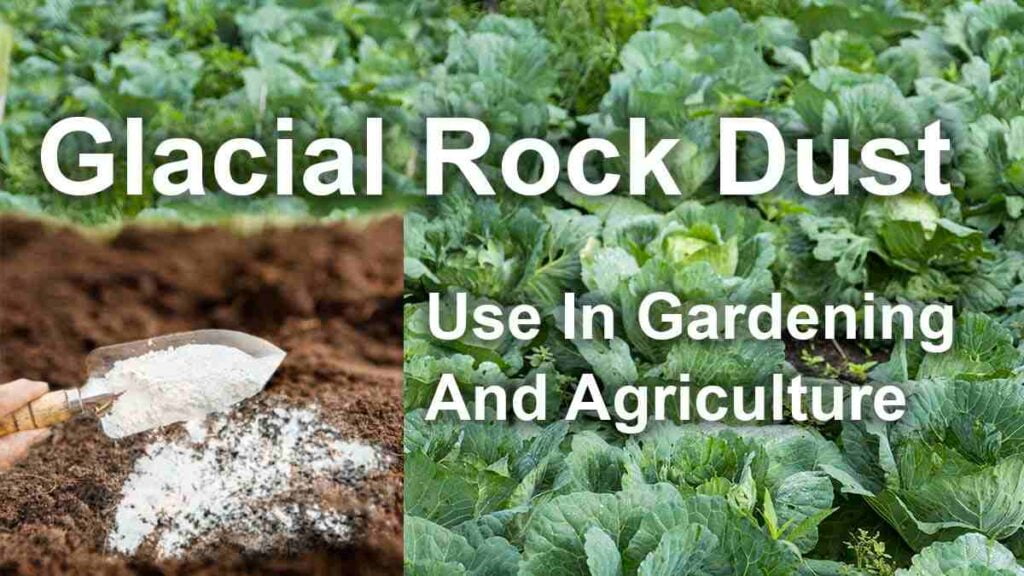Glacial Rock Dust is a finely ground powder made from different types of rocks such as basalt, granite and volcanic rock. It is also known as glacial flour or rock flour. The rock material is finely ground through the grinding action of glaciers over thousands of years. It is valued in gardening and agriculture for its unique mineral composition and the benefits it provides to soil and plant health. Here is a detailed overview of glacial rock dust including its mineral compositions, properties, typical analysis and advantages for gardening.
Mineral Compositions
Glacial Rock Dust is known for its mineral-rich composition that includes essential elements such as calcium, magnesium, iron and silica as well as a variety of trace minerals. This unique blend of minerals makes glacial rock dust useful for soil amendment. The mineral composition of glacial rock dust may differ depending on the source rocks. However, a standard analysis of glacial rock dust is as follows:
- Silica: Silica is an abundant component contributing to soil structure and plant health by strengthening cell walls and enhancing resistance to stressors.
- Calcium: Depending on the source rocks, glacial rock dust may contain calcium, which is essential for root development, cell division and overall plant structure.
- Magnesium: Some glacial rock dust may contain magnesium a central component of chlorophyll and essential for photosynthesis.
- Iron: Iron is necessary for chlorophyll formation and plays a role in oxygen transport within plants.
- Potassium: Depending on the source rocks, glacial rock dust may contain potassium, which is critical for regulating water uptake, nutrient transport and plant metabolism.
- Trace Minerals: Glacial rock dust can also contain various trace minerals such as zinc, copper and manganese which are important for enzymatic processes in plants.
Properties
Glacial rock dust is usually ground into very fine particles sometimes even finer than sand due to the continuous grinding action of glaciers over a long period of time. It has a powdery texture and its color may vary depending on the source rocks, but it is usually gray or tan.
Typical Analysis
The exact mineral composition of glacial rock dust can vary widely depending on the source rocks and geographic location. A typical analysis might include:
Benefits Of Glacial Rock Dust In Gardening
Glacial rock dust offers several advantages for gardening and agriculture:
- Improved Soil Fertility: Glacial rock dust enriches soil fertility by providing essential minerals and nutrients. It can help balance soil pH and provide a continuous source of nutrients for plant growth, leading to healthier and more productive plants.
- Enhanced Soil Structure: The fine particles in glacial rock dust can break up compacted soil, improve aeration and increase water retention. This results in better soil structure, root growth and overall plant health.
- Trace Minerals: Glacial rock dust often contains trace minerals that are essential for plant growth, even though they are required in smaller quantities. These trace minerals contribute to overall plant health and vitality.
- Environmental Benefits: The use of glacial rock dust is considered environmentally friendly, as it utilizes natural resources and reduces the need for synthetic soil conditioners.
- Improved Nutrient Density: Plants grown in soil amended with glacial rock dust tend to have higher nutrient content, making the produce more nutritious for consumption.
In summary, glacial rock dust is a valuable soil amendment due to its unique mineral composition and benefits for gardening and agriculture. It enhances soil fertility, improves soil structure, provides essential nutrients and promotes healthier and more productive plants. Gardeners and farmers often incorporate glacial rock dust into their soil management strategies to support sustainable and thriving crops.
How To Use Glacial Rock Dust In Your Garden
Mixing With Soil
To get the maximum benefits of glacial rock dust, mix it thoroughly with your garden soil. The recommended ratio is about 5-10 pounds of glacial rock dust per 100 square feet of soil.
Topdressing
Another method is topdressing, where you sprinkle the dust over the soil surface. This can be done periodically throughout the growing season to provide a steady supply of minerals to your plants.
Making Glacial Rock Dust Tea
You can also brew glacial rock dust tea by steeping it in water. This liquid solution can be sprayed on your plants’ leaves, providing them with a foliar nutrient boost.
Conclusion
As sustainable and environmentally conscious practices gain momentum, glacial rock dust is poised to play an even more significant role in agriculture and gardening. Its potential to enhance soil fertility and reduce the environmental impact of conventional farming methods makes it a promising option for the future. By incorporating glacial rock dust into your gardening or farming practices, you can promote healthier plants, improve soil structure and reduce your reliance on synthetic fertilizers.
Also Read
Limestone Dust Used In Gardening And Agriculture
Creative and Sustainable Use of Sawdust in Everyday Life
FAQs
Is Glacial Rock Dust safe for plants and the environment?
Yes, Glacial Rock Dust is safe for plants and the environment. It is a natural and sustainable soil conditioner.
Can I use Glacial Rock Dust for potted plants?
Absolutely, Glacial Rock Dust can be used for potted plants. Simply mix it into the potting soil or sprinkle it on the surface.
How long does it take to see results in my garden after using Glacial Rock Dust?
Results can vary, but you may start noticing improvements in plant health and growth within a few weeks to a couple of months.
Are there any alternatives to Glacial Rock Dust?
While there are alternative soil conditioners, Glacial Rock Dust’s unique mineral composition sets it apart.
Can I apply Glacial Rock Dust in all seasons?
Yes, you can use Glacial Rock Dust year-round. It is suitable for all seasons and provides consistent benefits to your plants and soil.

